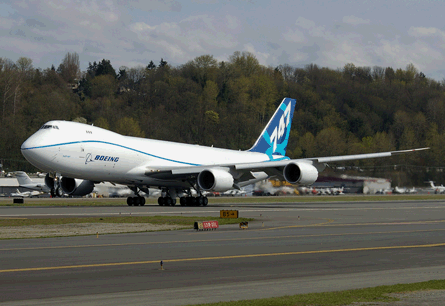Boeing is approaching a crucial phase in the 747-8 flight-test effort as it prepares to start trials of the -8I passenger variant and undertakes the dramatic maximum-brake-energy demonstration on the freighter version. It is also awaiting the analysis of back-to-back wake vortex testing, which will determine whether the stretched 747 will be approved in the same separation category as the smaller 747-400.
Four 747-8Fs are engaged in the flight-test programme, which began on 9 February 2010. "We've flown more than 600 flights and 1,600h so far," said Boeing Commercial Airplanes chief test pilot Capt Frank Santoni, addressing the Royal Aeronautical Society in London this week. "We'll start to fly the [-8I] Intercontinental test airplanes in the next couple of months."
 |
|---|
© Joe Walker |
Santoni says that Boeing will be able to leverage much of the testing carried out with the -8F for the -8I effort, in areas such as the engines and brakes. 747-8F certification is due later this year, and a key test that has been completed is the Vmu (minimum unstick speed) trial. In this, during take-offs, a wooden block is attached to the tail and is is deliberately dragged along the ground to determine the slowest flying speed. Close to 1,000 stalls have also been flown, adds Santoni. This test will not need to be re-run with the -8I.
Stall tests are now being flown with artificial ice shapes installed on the leading edges of the wing, tailplane and fin. "We're also doing the flight-loads survey - this is a big test where we put a lot of 'gs' on the airplane in different flap configurations to ensure the wing loads are correct," he adds.
The US Federal Aviation Administration is now "on board" 747-8 flights for certification tests, and within the next month the maximum brake energy test is due to be carried out.
"This will be done at the highest maximum take-off weight - 975,000lb [442,650kg] - with the take-off rejected at a yet-to-be-determined speed but it will be in the 180-185kt [333-342km/h] region," says Santoni.
To determine whether the 747-8's wake vortex is significantly different to a 747-400, back-to-back trials have been flown at Fresno, California using a lidar (light detection and ranging) system that measured the strength of the vortex as each aircraft passed down the glideslope, says Santoni. "The data is still being analysed, but the hope is that there will not be a significant difference so the 747-8 will be approved for the same separation requirements that we have today for the 747-400."
Airbus has flown a series of similar back-to-back trials comparing the A380 with other large widebody types, including the 747-400, to help determine the double-decker's separation requirements, which has its own wake category.
Source: Flight International



















